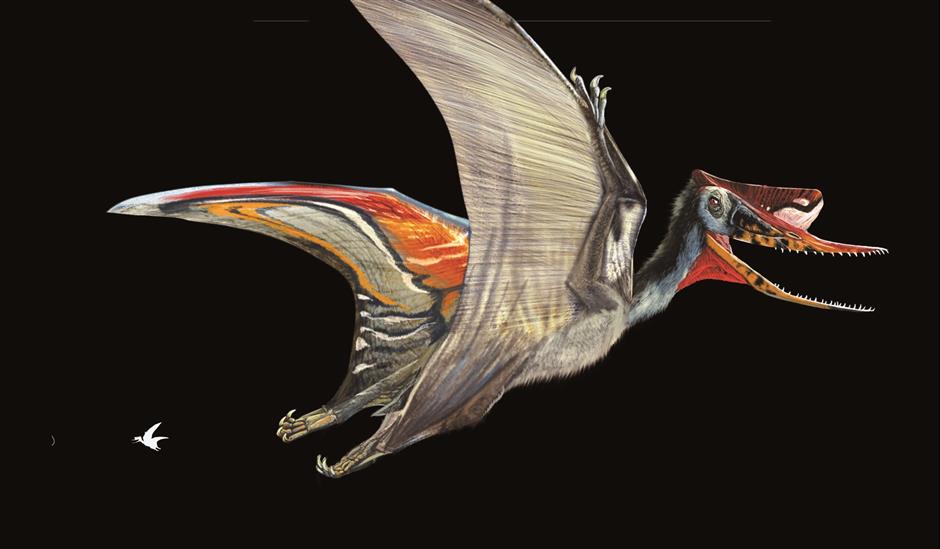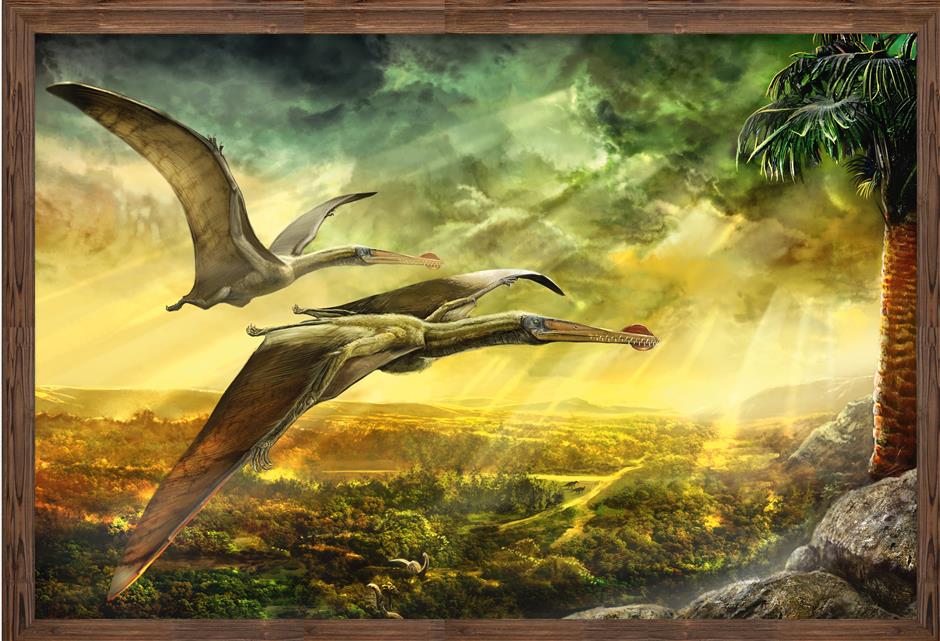Making art out of passion for dinosaurs

Zhao Chuang's illustration of ceresiosaurus
It was a love at first sight for Zhao Chuang when he encountered tyrannosaurus in a science book as a boy. At seven, he started drawing dinosaurs, trying all he could to gather information so that the illustrations were more accurate.
The dinosaur-loving boy didn’t expect to turn his passion into a career years later, not to mention becoming the first Chinese to have his reconstructive illustration published on the cover of the science journal Nature.
“They call me a scientific artist,” Zhao says shyly, his voice in contrast to his rugged appearance. “Well, I paint animals, and most of all, dinosaurs.”
He was being more than humble. Zhao, 31, has recreated almost all of the 2,000-plus types of dinosaurs discovered in the world so far, in illustrations, sculptures and 3D models.
He has been building a database of his dinosaur illustrations for more than 10 years and may open it for academic research in the future.
Recently at the Shanghai Book Fair, the painter was surrounded by kids, mostly young boys like a little Zhao of many years ago, who refused to let him go and kept asking for more about dinosaurs after an entire hourlong lecture.

Children and parents form a long line at the recent Shanghai Book Fair awaiting Zhao Chuang's sketch and autograph.

Zhao Chuang draws a sketch of tyrannosaurus especially for Shanghai Daily readers.
His newly published Pecking Nature Science Organization kids’ encyclopedia about dinosaurs contains hundreds of reconstructive illustrations and has become an instant bestseller in the category of popular science.
Many of the dinosaurs in the book are beautifully feathered and colored like birds, unlike the grayish bold fierce tyrannosaurus or velociraptor in the “Jurassic Park” movies.
“The first ‘Jurassic Park’ was made in 1992 and was done quite well considering its time,” Zhao says. “But more fossils have been discovered after that, filling the blanks and changing previous conceptions.”
One of the biggest misconceptions about dinosaurs is that they were hairless, but the large amount of fossils discovered in China’s northeastern Liaoning Province proved that many dinosaurs had colorful feathered wings like modern birds.
“The microraptor and anchiornis, the small four-winged paravian dinosaur otherwise known as Huxley’s nearby bird, are both very similar to birds. Some of the fossils contain patterns and pigments that can be used to estimate the original color,” Zhao says. “To some extent, dinosaurs didn’t go extinct because their descendants, birds, still fill the sky today.”
His eyes shone with excitement and his body language was no longer stiff when talking about dinosaurs, and he needed no questions or hints to continue.
Zhao doesn’t speak much English, but the long Latin names of dinosaurs kept popping out. After all, his daily routine as a scientific artist includes keeping up to date with the latest paleontology papers from all around the world, working with paleontologists on field trips at home and abroad and discussing with scientists about how many teeth a dinosaur has or what a particular wing looks like when fully stretched, amid other seemingly un-artsy tasks.
“There is a clear distinction between my more artsy illustrations for exhibitions for children’s books and the more scientific works for scientists,” Zhao says. “The illustrations are done according to their papers, and the poses of the dinosaurs are designed to present what is highlighted in the paper, such as opening its mouth to reveal the number and features of the teeth, keeping one wing stretched and the other not to show the different status of the wing ...”
He has been working with paleontologists all over the world since 2006, when Chinese scientist Wang Xiaolin came across a reconstructive illustration of the squirrel-like volaticotherium antiqum discovered in Inner Mongolia Autonomous Region that Zhao posted on the BBS of the Institute of Vertebrate Paleontology and Paleoanthropology in China.
Surprised by the scientific accuracy of the illustration, Wang reached out to the painter, at the time a sophomore design student, and asked him to make illustrations to match his team’s papers for Nature. One of Zhao's illustrations ended up on the cover of that issue in December 2006.

Zhao Chuang has developed his childhood craze for dinosaurs into a lifelong career.
As he strode into this new world, Zhao came to realize that he could turn his favorite hobby into a career.
“The scientists took me on field trips to unearth the fossils, to learn about the environment they once lived in, and to take close looks at the real fossils to get a feel of how they lived, ate, slept and died,” he says. “There are new discoveries every once a while that change previous assumptions, and you just have to keep updated.”
For example, he adds, the image of triceratops was wrong even only 10 years ago, because scientists had no evidence of how the skin looked like, and had to make estimates according to its close relative, the centrosaurus or “pointed lizard.”
But in recent years, triceratops fossils containing parts of skin were discovered, proving the previous estimates to be completely wrong.
Another example is tyrannosaurus, possibly the best-known dinosaurs.
“The common perception is that the fierce beast just goes out alone to eat others,” Zhao says. “In fact, it is not a lone walker. Many species of tyrannosaurus moved in groups, proved by their fossils that were discovered together. Many dinosaurs lived as a community, and their fossils were found to be piles of hundreds or even thousands.”
Zhao allows himself more flexibility and artistic imagination for children’s books, in which he pays more attention to reveal the dinosaurs’ emotions related to the story.
For example, Zhao was invited to make a short introduction video for a special exhibition when Beibeilong was returned to China in 2013. The nest fossil containing an embryo nicknamed Baby Louie and eggs was discovered in 1992 in central China’s Henan Province and quickly smuggled out of the country.
“I wanted to make something more than a simple documentary or introduction,” Zhao recalls.
The 7-minute animation reconstructs how the nest, estimated to exist in the cretaceous period, was hit by a disastrous flood and buried under the soil just as Baby Louie was breaking out of the egg. His parents, unable to save the nest, had to run from the flood in desperation.
“My favorite dinosaur is the thick-headed lizard, the one with a big dome on his head,” Zhao reveals, looking like he can continue talking for another few hours.
“I like the strange-looking ones, those that look very different from today’s animals. In fact, that big dome on his head is supposed to be multi-colored and beautiful too,” he adds.

Zhao Chuang's illustration of normannognathus

Zhao Chuang's illustration of ornithocheirus
















